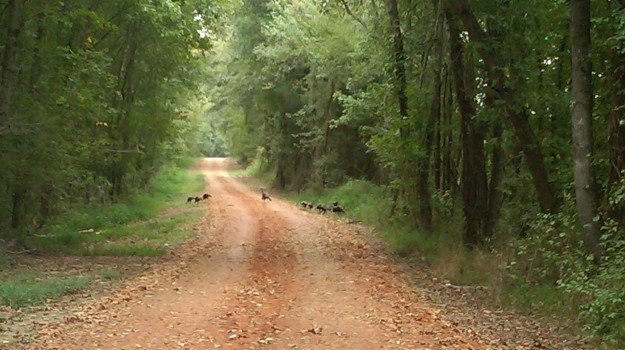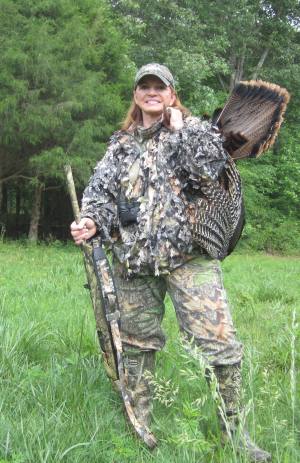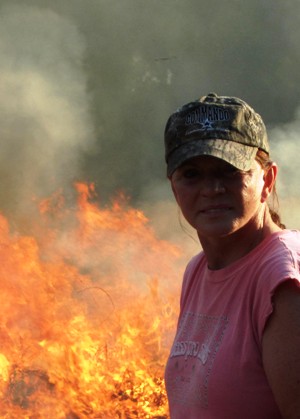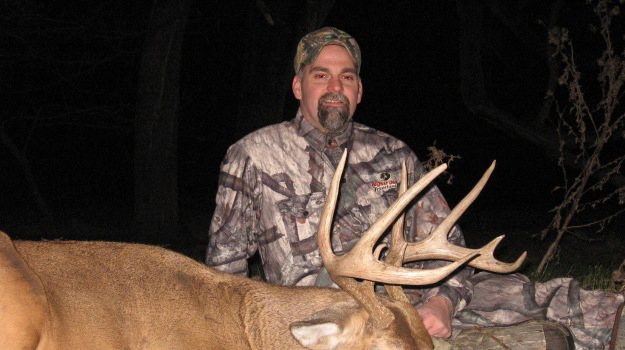The Attraction of a Property Pulls a GameKeeper Near
By Brenda Valentine

Albert Quitman Wood, known only as “Quit” by most folks, grabbed the water bucket and walked the familiar 100 yard path to the spring at the bottom of the hill. The old dog that had just showed up a couple of years back fell in step at his heels. Quit had gone to town that morning, stopped at city hall and tended to other business. It was a four mile trip from his small cabin off Clear Creek to the bustling railroad town of Puryear, TN. It was the typical small southern town with a smattering of houses, a bank, lumber house, school, blacksmith shop, 3 general stores and as many churches. “The Great Depression” had a strangle-hold on the entire country, these were desperate times.
Quit dipped a bucket of the cold clear spring water that bubbled out the side of the hill. Tall oaks and straight yellow poplars surrounded the spring, making for a shady oasis in summer and a major cleaning chore during fall when the leaves change glorious colors and descend from their summer-green posture and taint the water. A dipper hung on a nail driven in a straight, cherry-bark red oak for anyone who might happen by in need of a drink of cool, sweet water. That was fairly unlikely since Quit was reclusive and lived alone on this remote farm. With a bucket full of fresh water the old man and his dog commenced back up the path to the small cabin surrounded by sturdy white oak trees.
Most likely Quit never heard the shot that sent a small caliber bullet through his head, entering near the right ear and coming to a stop in the left eardrum. And for certain he didn't hear the second shot that pierced his skull from behind and lodged in the brain. The date was February 3, 1935 and the motive was robbery. Four days later, Curtis Barrett discovered Quit’s stiff body near the red oak tree, the faithful old dog still curled up by his master, rodents had gnawed one ear pretty badly. Sheriff Caldwell came out to investigate but there were no clues just a dead man with empty pockets. The Puryear Lumber Co. ran a sideline undertaker business offering handmade caskets and a $25 embalming service. The burial was held the next day. Old Quit was put away in style with a concrete vault and a new $15 suit complete with new socks and underwear. Total cost of the funeral was $291.04.
One week later his short list of personal property was sold - all but the land on which he had sweated and toiled. Someone nailed Quit's old leather hat to a tree by the spring where it remained for decades as a poignant reminder of the man who once tended the land and the evil that had taken place there. Superstitions hatched quickly about the spirit of the reclusive old man and how he roamed the property seeking revenge on whoever took him from it. Some of those tales still surface from time to time
In his younger days, Quit left the country and sought his fortune in the big city. He learned the jewelry making trade in Chicago, faring well enough to come back home, buy a mule and his own piece of land. One can only imagine the contrast of the bright lights of Chicago to the quiet peacefulness of the farm at Clear Creek with only the stars overhead and summer lightening bugs to illuminate the night sky. Electricity would not come to parts of rural west Tennessee for another 15 years after the murder.
During the next couple of years, Quit put together four small parcels of adjoining land that created a nice size farm for this part of the country. He had a free and clear deed to everything. Folks in the community all whispered that he was rich and peculiar, but Quit mostly kept to himself and let them whisper whatever they pleased. The land itself was Quit's chief fortune and he had plans to make it better.
The property could adequately support his simple lifestyle. It lay in a long rectangle shape with 4 clearly defined ecosystems. A steep hardwood covered ridge ran the length of the property on the north side, full of scaly-bark hickory, wild cherry, white and red oaks. Narrow bottom-land fields lay between the base of the hillside and a spring-fed creek to the south. Beyond the creek were great stands of bald cypress, water oaks, willow and gum trees in, and around a slough. This farm could supply all the firewood and lumber he would ever need. The rich meadows would grow corn and hay for his mule plus a bountiful garden for himself. There was the fresh water from the spring that flowed year-round plus the deep holes in the creek had a few fine fish. The mast-producing hardwoods on the hillside and the swampy bottom were teeming with small game that would supply fresh meat for the table.
Quit planted an orchard of fruit trees near the cabin. Sometimes in the dead of summer he slept on a pallet out in the orchard where the night-time breezes made the heat more tolerable. He fenced a small lot with hand-tied, woven wire for his hard-working mule. No one will ever know the full extent of his unfinished plans for improving the property, but the few that remain to this day are a lasting testament of his doggedness for accomplishing seemingly impossible conservation efforts. Although, conservation was probably not an oft used word back then. More than likely Quit just knew to take care of the land, and in return it would take care of him.
Equipped with only a mule and a pond scoop Quit moved tons of dirt and built a berm along the base of the hardwood ridge. The berm runs several hundred yards long and still stands 6-7 feet tall in some places. It is 5-8 feet wide and as smooth and flat on top as a train track. The packed earth is as solid as a rock and now has large trees firmly growing along its path. The huge amounts of dirt required to build a wall of this size and strength created a chain of holding ponds to catch rain run-off from the steep hillside preventing erosion or possible flooding of the rich bottomland fields. This would have been a monumental undertaking if equipped with a bulldozer and earth compacter. It is beyond comprehension that one man and a mule could move this much earth and reposition it so perfectly that much of it would survive over 80 years of wear and erosion.
With the water run-off halted by the lengthy retainer wall and contained in the holding ponds, Quit tackled another major undertaking. He built concrete forms from rough sawmill boards and poured two reinforced concrete foundations. One near the cabin that would most likely have been a small barn or shed, and the other was much more complex, in that it started at the edge of the retainer berm and extended out into the water of the holding pond. Both projects were halted by his untimely death. The substantial foundation in the pond is as straight and strong today as it was the day he removed the forms. There is not a crack in the concrete or in the mystery surrounding its purpose. Speculation through the ages has been that he intended to put a grist mill there. I don't follow that line of thinking since the running creek would have been a better option and besides, the Martin Mill was not far to go to have his corn ground. It has also been suggested that he had, on occasion, mentioned his desire to have a house built over water. The strange concrete works will remain a mystery along with who ambushed and murdered Quit Wood.
Two years after the shooting, Quit's relatives sold the farm to a mineral mining company that also ran cattle and row cropped much of their massive land holdings. Sturdy fences were strung, access roads were gated and the cabin was bulldozed away. The old Quit Wood place slept quietly behind locked gates through WWII, Korea and Vietnam, moon landings, wildlife restoration and all matters of "progress." Herford cattle ranged there for a while and eventually the narrow fields were plowed and planted in row crops, just waiting for the day when the land would be bulldozed clean and excavated for the clay lying far below the surface.
Due to advanced farming practices and ever-increasing yield demands plus the unique lay of the land neither grazing nor farming were particularly productive. The fields on Quit's old place had become depleted and were left fallow for the briars and bushes to overtake. In recent years the mining company changed ownership and the new conglomerate streamlined land holdings and properties in-waiting. Parcels not containing certain types and amounts of clay were put on the market for sale.
 I had known about the old Wood's place for a long time, along with the legends and the superstitions that surrounded it. However, I'd never actually given thought to owning it till the long-locked gates were opened and out of curiosity I went in. I can only describe the feeling as a "pull." Actually, I can't adequately describe it at all. It was as if I felt I was needed in some unexplainable way. I found myself waking up at night and driving over to the place only to sit in the truck and listen to the night sounds.
I had known about the old Wood's place for a long time, along with the legends and the superstitions that surrounded it. However, I'd never actually given thought to owning it till the long-locked gates were opened and out of curiosity I went in. I can only describe the feeling as a "pull." Actually, I can't adequately describe it at all. It was as if I felt I was needed in some unexplainable way. I found myself waking up at night and driving over to the place only to sit in the truck and listen to the night sounds.
Some mornings I would slip in quietly before dawn to watch the world wake up. I'm not a superstitious kind of gal but I was beginning to wonder if it was ol' Quit that was calling me. Little did he know it wasn't in my plans to make that kind of financial or sweat commitment. I don't know if it was Quit Wood or the land itself that had my direct number but the calling continued. Family and friends questioned my sanity for considering the project I had in mind. Most likely old Quit heard similar comments when he started moving a mountain with a mule. Thank goodness my banker seemed to understand, and if he didn't, at least he went along with my request to buy the farm.
I have always lived on a farm and know my way around dirt, sweat, livestock, and tractors, but this was now my own personal conservation farming project. From the beginning the only two guidelines I set were 1) did it improve and nurture the land, and 2) did it benefit the wildlife. I figured that what was good for the land and the wildlife would ultimately be good for me and if not, it was still the right thing to do. This farm was not about making a profit and so far there has been no government cost sharing programs. I simply had a burning desire to care for and give back to a neglected piece of land, a need to see good stuff grow and to have every kind of wildlife flourish there.
Besides the nice old trees, which thank goodness had never been timbered, the only things I found really thriving was ticks and cockleburs. Kudzu, black locust, copper heads and yellow jackets were also way too plentiful. In the beginning I fought the thick weeds, briars, and bushes with herbicide, brush-hog, fire, hoe and bare hands. Whenever I drew near exhaustion and tears I would think of Quit and that mule doing the back breaking work that must have taken years. It never failed to renew my energy and give me a second wind.
Thanks to Toxey Haas and the guys at Native Nurseries, a new orchard was planted with various apple, pear, and hard mast producing trees. During extended dry spells we haul water and hope they will survive. Bobby Cole offered advice on successful seed and soil combinations plus options for long-term food plot goals. I took advantage of the NWTF membership seed program for grain seed and sampled a few exotic varieties from time to time.
 Farmers are eternal optimists, and we plowed and planted each plot with visions of lush offerings to tempt the wildlife in every field. The truth was that first spring and summer after liberally spreading lime, fertilizer and seed all I got was dust. The old hand seeder with several patches on the canvas bag got quite a workout. Every time it looked like it might rain I cranked out a few more seeds hoping to get a decent stand of anything green before winter.
Farmers are eternal optimists, and we plowed and planted each plot with visions of lush offerings to tempt the wildlife in every field. The truth was that first spring and summer after liberally spreading lime, fertilizer and seed all I got was dust. The old hand seeder with several patches on the canvas bag got quite a workout. Every time it looked like it might rain I cranked out a few more seeds hoping to get a decent stand of anything green before winter.
Not one animal was taken off the property that first year. The next spring I found 2 old foundation sandstones from Quit's long- gone cabin, a hand-forged mule shoe and fragments of hand-woven wire grown into trees. Thousands of buttercups showed their cheerful heads around the old homestead under the ancient white oak trees. These things reinforced my resolve to continue to work diligently for the good of the land and the wildlife.
It's been over 3 years and I am still enamored with the farm. Working there calms my soul and slows my spinning world. It energizes me and fills me with inspiration. The fields are beautifully producing a variety of nutritious wildlife forage. Every day I see deer and turkey prospering from the bountiful table that is set just for them. These are animals that Quit never imagined might someday share the same spring water as he. We built a small primitive cabin in the woods remindful of those of yesteryear. The cherry bark red oaks and the yellow poplars still stand tall around the spring creating a shady oasis in the summer and a leafy mess in the fall. There is a new dipper hanging on a nail for tasting that cool sweet spring water. It's been a spell since Quit called, I hope he is now resting in peace.




























